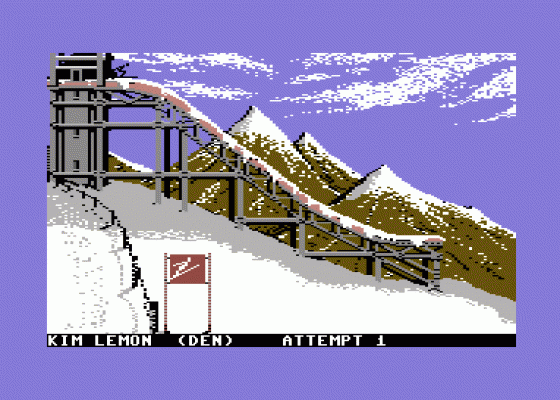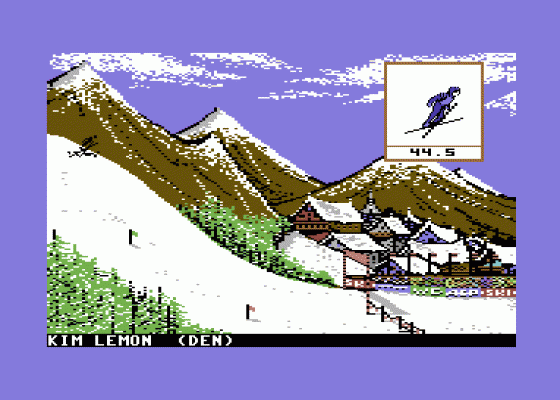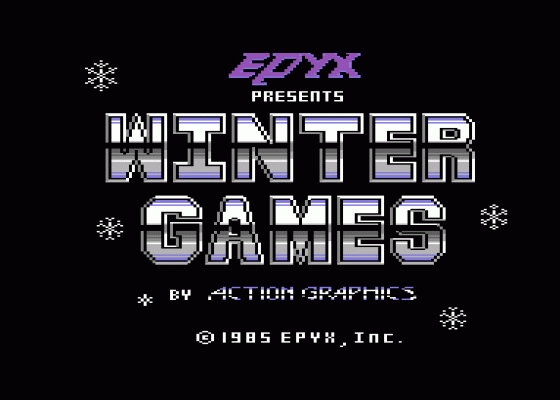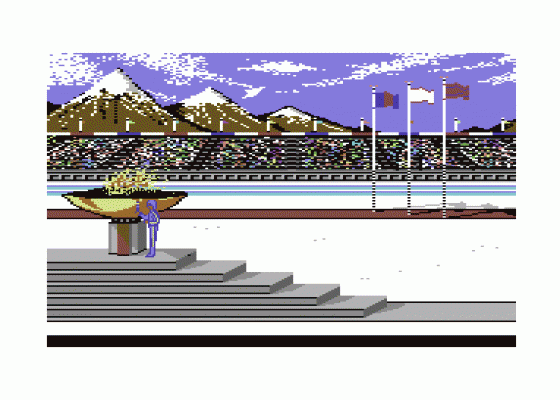
Computer Gamer
 1st November 1985
1st November 1985
Categories: Review: Software
Author: Eric Doyle
Publisher: U. S. Gold
Machine: Commodore 64
Published in Computer Gamer #8
US Gold hopes to follow up the success of Summer Games II with the latest sports simulation from Epyx. Eric Doyle heads for the slopes to investigate.
Winter Games
Now that the Summer Olympics are well and truly behind us, we can look forward to the thrills and spills of the Winter Olympics. In anticipation, Epyz have brought out their follow up to the truly excellent Summer Games package.
Winter Games is a collection of seven events: Bobsled, Ski Jump, Figure Skating, Speed Skating, Hot Dog Aerials and Biathlon with an Opening Ceremony added for good measure. Reading the presentation box sleeve notes I notice that it only claims to contain six events and that Speed Skating is not mentioned but it certainly appears on the disk.
The standard of the graphics is truly amazing and the main quality of the game is that each sport requires a different approach on the part of the player, not just mindless joystick waggling.

The program of events starts with the familiar Opening Ceremony. As the athlete runs up and lights the Eternal Flame a flock of white doves are released to circle the stadium. This scenario continues for as long as you want it to but a swift jab of the fire button takes you in to the first menu of the program whch offers a wide choice of options.
If you wish, you can opt to enter all of the events in a fixed sequence of a selection of your favourite events can be made in any order which you prefer. If only you sport is preferred, this can be catered for either going for gold in a competition or merely practising to perfect your technique.
If you opt for the Games, you may then enter your name and the country which you wish to represent. The screen displays a range of national flags including that of that well-known country Epyx! For those who may be influenced by the stirring strains of a national anthem, each country's patriotic tune can be played until you find one that is truly inspirational. It soon becomes obvious that this is not a home produced game when the British anthem is heard! Unfortunately, the tune has a horribly off-key tone which I found to be the only irritating feature of the program. Naturally enough, the American anthem is note-perfect.

Taking each event in turn, I'll start with the peculiarly American hot Dog Aerial event. For those, like me, who may not be familiar with this event I'll explain that it resembles ski-jumping. The difference being that the competitor does not start his jump from the same giddy heights as in a jumping event and, whilst in the air, he must perform as many acrobatic feats as possible, before making a perfect landing.
Just as the title has an American slang sound to it, some of the movements have typically American names like the mule kick and the daffy. Forward and backward somersaults are also possible, as well as a variation of the mule kick known as the back scratcher.
I found that two tricks were the maximum I could perform in any jump and that the highest score was 9.2 for a double somersault. Trying to perform two different moves in one jump does not seem to carry many extra marks despite the difficulty of moving the joystick around to select these moves during the short flight period.

At the end of the jump, the international judge's marks are displayed and the final column of the display shows the average mark which you have been awarded.
Frequently my efforts were rewarded with a rather ungraceful touchdown which has allowed the programmers to add a touch of comedy to the game. Depending on your athlete's position on landing, you are left either looking at a pair of feet sticking out of the snow or two skis sticking up vertically whilst your athlete sprawls out on his stomach.
Similarly, in the ski jumping event failure to press the fire button at the right point on the run up to the jump results in an embarrassing tumble at the end of the ramp. Success does not mean your troubles are over because the scene changes from the ramp itself to the actual flight over the course. An inset picture shows the physical attitude of your jumper in the air and moving the joystick around enables you to try to maintain the optimum body position for the longest possible jump.

Keeping the skis together and the body rigid requires a fair amount of skill and practice, and points are awarded for style as well as the length of the jump. The main thing to remember is that you mustn't fall down or points will not be awarded. The flight becomes a wild battle at times in which you struggle to achieve the correct landing position to avoid having to watch the skier in the inset picture skidding across the snow on his belly.
The Biathlon which combines cross-country skiing with target shooting, and the Speed Skating events resemble the kind of joystick waggling sport simuations which I have come to know and loathe over the past year or so. I am pleased to say that in this case there is much more skill required because if you don't gradually increase the speed of your athlete, then his progress will actually be slowed down. Pushing left on the joystic moves the left leg forward, pushing right moves the right leg. Move too fast too soon and the athlete's timing is thrown out, resulting in a loss of speed. Co-ordination is the important skill, not the speed of waggling.
The Biathlete must cross flat country and steep upward and downward slopes to reach each of the three target shooting sights. The hardest part of this is getting the timing right on the upward slope otherwise you have to work harder to reach the top and a little icon of a heart at the bottom of the screen beats faster affecting your athlete's overall performance due to fatigue.

This event is a race against the clock and penalty points can be crucial at the target shooting stages. When you reach one of these points you must load the gun before each shot by pulling and pushing the joystick. A gunsight drops down across each target in constant motion and you have to press the fire button when you think that the sight is over the centre of the target. A miss results in a penalty which adds five seconds to your time.
Speed skating is a very straight-forward event and I don't just mean that there are no corners to be turned. The screen display shows your athlete and a computer-controlled pacemaker in their respective lanes. The screen at first looks as though there are four skaters but this is the same image repeated twice, one keeping track of the pacemaker's progress and the other concentrating on you. This is initially confusing, but I soon found that I could get a very good impression of my performance from this display.
The only skill required is timing. Moving the joystick back and forth, faster and faster is the aim for a record speed.

The other two skating events (figure and free-styles) are disappointingly similar to one another. In both cases, the range of jumps and spins ar the same; the difference being the time alloted to the performance and the number of times which each action must be performed.
These are the only ladies' events in the Games and allow a certain amount of artistic freedom in the order in which the various movements are tacked.
The skater moves by herself but you determine whether she skates forwards or backwards depending on which of the six jumps and spins she will be made to perform next. Each move is initiated by moving the joystick to the required position and pressing the fire button. For a jump, the fire button must be pressed again to ensure a graceful landing. Failure to do so results in a rather embarrassing fall.

Of all the games, these two rely on perfect timing to gain the highest scores. Start a move too early and the judges will mark you down for it; make too many spins and the result is a fall because of dizziness. At the end of each performance, the judge's scores are displayed and an average taken.
I've saved my favourite event until last. The Bobsled is probably the least sophisticated of the games, and yet the most visually exciting. The screen shows three displays at once: a plan view of the course so you can keep a lookout for the sharp corners, a speed indicator panel and an action screen which follows behind the bobsleigh along the course.
The basic idea is to ride the bends as high as you dare to gain speed. Ride too high and you crash, too low and you won't gain enough speed. Control is achieved by pushing the joystick in the direction of the bend so you have to think quickly.

The 3D action screen is very realistic indeed, and passing under spectators on the bridges gives a real impression of the speed and the excitement of the real thing. Although I have said this is my favourite, I think it may get boring after I recover from this initial exhilaration, because there is very little control over the game. It's certain one to impress your friends with though.
After completion of each event, the computer checks the World Record stored on the disk to see if the current performance has exceeded previous attempts and updates the chart accordingly. If the current score equals the previous record, the chart is updated which does not reflect the real world of sport, where a record stands until broken, but I suppose such sterling effort does deserve some reward. Next, an award table is displayed, giving the vital statistics of the medal-winning efforts and the name and nationality of the winning competitors. At the same time, the flag of the Gold Medallist is displayed and the anthem played.
As a package, Winter Games is excellent value for money. The graphics are superb, showing masterly control of the C64's facilities, though I must confess that I slightly prefer the Summer Games collection overall.
Each event is loaded from disk when required but the loading time is mercifully short, though I feel sure the cassette version will not be quite as fast or as flexible in use. I think I am on very safe ground when I forecast that this will be a number one top-seller around Christmas time.
Other Reviews Of Winter Games For The Commodore 64
Winter Games (US Gold/Epyx)
A review
Winter Games Vs. Winter Sports (Electric Dreams)
A review
Winter Games (Epyx/US Gold)
A review by Mike Pattenden (Commodore User)








